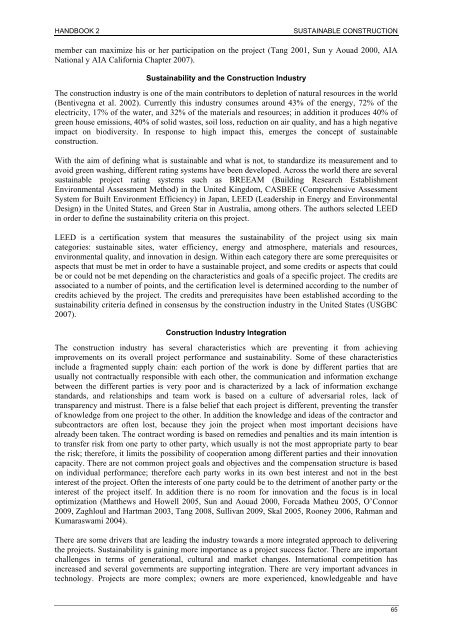Industrialised, Integrated, Intelligent sustainable Construction - I3con
Industrialised, Integrated, Intelligent sustainable Construction - I3con
Industrialised, Integrated, Intelligent sustainable Construction - I3con
You also want an ePaper? Increase the reach of your titles
YUMPU automatically turns print PDFs into web optimized ePapers that Google loves.
HANDBOOK 2 SUSTAINABLE CONSTRUCTION<br />
member can maximize his or her participation on the project (Tang 2001, Sun y Aouad 2000, AIA<br />
National y AIA California Chapter 2007).<br />
Sustainability and the <strong>Construction</strong> Industry<br />
The construction industry is one of the main contributors to depletion of natural resources in the world<br />
(Bentivegna et al. 2002). Currently this industry consumes around 43% of the energy, 72% of the<br />
electricity, 17% of the water, and 32% of the materials and resources; in addition it produces 40% of<br />
green house emissions, 40% of solid wastes, soil loss, reduction on air quality, and has a high negative<br />
impact on biodiversity. In response to high impact this, emerges the concept of <strong>sustainable</strong><br />
construction.<br />
With the aim of defining what is <strong>sustainable</strong> and what is not, to standardize its measurement and to<br />
avoid green washing, different rating systems have been developed. Across the world there are several<br />
<strong>sustainable</strong> project rating systems such as BREEAM (Building Research Establishment<br />
Environmental Assessment Method) in the United Kingdom, CASBEE (Comprehensive Assessment<br />
System for Built Environment Efficiency) in Japan, LEED (Leadership in Energy and Environmental<br />
Design) in the United States, and Green Star in Australia, among others. The authors selected LEED<br />
in order to define the sustainability criteria on this project.<br />
LEED is a certification system that measures the sustainability of the project using six main<br />
categories: <strong>sustainable</strong> sites, water efficiency, energy and atmosphere, materials and resources,<br />
environmental quality, and innovation in design. Within each category there are some prerequisites or<br />
aspects that must be met in order to have a <strong>sustainable</strong> project, and some credits or aspects that could<br />
be or could not be met depending on the characteristics and goals of a specific project. The credits are<br />
associated to a number of points, and the certification level is determined according to the number of<br />
credits achieved by the project. The credits and prerequisites have been established according to the<br />
sustainability criteria defined in consensus by the construction industry in the United States (USGBC<br />
2007).<br />
<strong>Construction</strong> Industry Integration<br />
The construction industry has several characteristics which are preventing it from achieving<br />
improvements on its overall project performance and sustainability. Some of these characteristics<br />
include a fragmented supply chain: each portion of the work is done by different parties that are<br />
usually not contractually responsible with each other, the communication and information exchange<br />
between the different parties is very poor and is characterized by a lack of information exchange<br />
standards, and relationships and team work is based on a culture of adversarial roles, lack of<br />
transparency and mistrust. There is a false belief that each project is different, preventing the transfer<br />
of knowledge from one project to the other. In addition the knowledge and ideas of the contractor and<br />
subcontractors are often lost, because they join the project when most important decisions have<br />
already been taken. The contract wording is based on remedies and penalties and its main intention is<br />
to transfer risk from one party to other party, which usually is not the most appropriate party to bear<br />
the risk; therefore, it limits the possibility of cooperation among different parties and their innovation<br />
capacity. There are not common project goals and objectives and the compensation structure is based<br />
on individual performance; therefore each party works in its own best interest and not in the best<br />
interest of the project. Often the interests of one party could be to the detriment of another party or the<br />
interest of the project itself. In addition there is no room for innovation and the focus is in local<br />
optimization (Matthews and Howell 2005, Sun and Aouad 2000, Forcada Matheu 2005, O’Connor<br />
2009, Zaghloul and Hartman 2003, Tang 2008, Sullivan 2009, Skal 2005, Rooney 2006, Rahman and<br />
Kumaraswami 2004).<br />
There are some drivers that are leading the industry towards a more integrated approach to delivering<br />
the projects. Sustainability is gaining more importance as a project success factor. There are important<br />
challenges in terms of generational, cultural and market changes. International competition has<br />
increased and several governments are supporting integration. There are very important advances in<br />
technology. Projects are more complex; owners are more experienced, knowledgeable and have<br />
65






